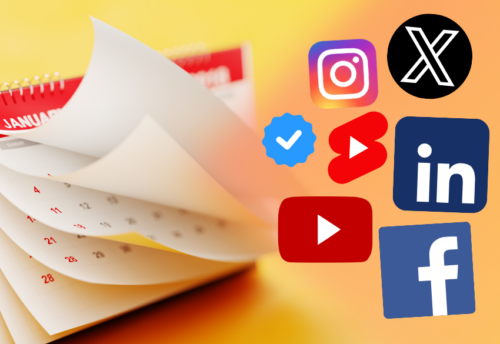
SES Chicago 2012 Recap from a Social Media Marketer
 I was lucky enough to attend the SES Chicago (Search Engine Strategies) conference this last week, and I wanted to share with you a few nuggets of information that I found worthwhile.
I was lucky enough to attend the SES Chicago (Search Engine Strategies) conference this last week, and I wanted to share with you a few nuggets of information that I found worthwhile.
While a majority of the SES Chicago sessions weren’t quite up my social media-alley, there were many take-aways that you social media marketers could use.
Facebook Tips
- There are four things that every marketer should measure within Facebook: Conversion rate, amplification rate, Applause rate, and Economic value. (Tweet this)
- Conversion Rate = # of audience comments (or replies) per post
- Amplification Rate = # of shares/retweets on Twitter, YouTube, Google+, Facebook, etc. per post
- Applause Rate = # of favorite clicks (Twitter), likes (Facebook), +1’s (Google+) per post
- Economic Value = Sum of Short and Long Term Revenue and Cost Savings (I’ll address that later in the post)
- If you’re struggling with ideas of what to post, create an calendar and give each month, week, or day of the week a theme and stick with it. For example, you could do Monday recipes, Wednesday mid-week roundups, Friday funnies, etc. Or one week could be dedicated to entirely one facet/product of your business.
- When you create a Facebook ad, try and keep the user within Facebook. If you send the user off of Facebook (even to your site), conversion rate drops considerably. (Tweet this)
- Add your website URL in the bio that appears right under your profile pic. This will help the user easily find your site and will drive your traffic up.
- Facebook only displays 0.8% of all the possible activity that could show up on your news feed from your friends and pages you “like”. Moral of the story: Facebook is censoring what the user sees, you have to focus on posting great content, every time.
- When looking that your posts’ virality rate that Facebook provides, a good benchmark is 2-5%. (Tweet this)
Twitter Tips
- Two tools that were recommended to check out were www.twellow.com (A search directory of people by area of expertise, profession or other attribute listed in personal profiles on Twitter), and www.listorious.com (Twitter tool that allows you to view and follow public lists posted by other Twitter users).
- If you use Chrome as your internet browser, install the Klout extension; when looking at your Twitter feed within Twitter.com, this extension will display the person’s Klout score within their tweet. (Tweet this)
YouTube Tips
- When posting a video to YouTube and you’re entering tag words, your first tag word should be your most important keyword as it helps your video be found more than any other.
- When writing your video description, put a link linking to the associated blog post at the beginning of the description (assuming you have a blog post written about the video, which if you don’t, you should).
- When putting a link of the associated blog post at the description, if possible, don’t shorten the link with any URL shortener. Shortened URLs are not as trustworthy and have lower click-through rates. (Tweet this)
Blogging Tips
- Create tweetable links within your blog post (like I’ve done here). For example, when you have a “golden nugget” of information or quote that you think is worth tweeting, put a “(Tweet this)” hyperlink directly after it so that all a reader has to do is click on the link to retweet that “golden nugget”. If you make sharing easy for the reader, and do the work for them, they’re more likely to pass it along to their friends. Hubspot did this and sharing went up 1,000%. (Tweet this) 😉
- Make your articles & blog posts “tweetable” by choosing a title of your blog post that is between 70-100 characters; if the title is longer than 100 characters, chances of your post being shared socially goes down dramatically.
- Make sure you include images within your post; website content with images get 47% more clicks. (Tweet this)
- Properly label your images as well as add meta descriptions and alternate text. This will help your images be found on Google image searches which comprise of 7% of all searches on Google.
- When posting an infographic on your blog, put instructions above or below it showing how to repost that infographic to their blog and give them the link to do so. This will give you a back-link and will help improve your SEO.
General Social Media Tips
- User behavior has forever changed, therefore, your marketing strategy must change with it. (Tweet this)
- If you’re using social media for lead generation and want to track if your leads came from social media, the only way to do that is to ask them on the form or create a separate landing page for each social platform.
- One study claims that 86% of brands now use Facebook and/or Twitter. (Tweet this)
- When measuring the value of Social Media and its ROI, do not forget to calculate its cost savings (direct and indirect) to your company as well as the revenue generated.
-Lance Brown




Pingback: SES Chicago 2012 Coverage #SESChi | SEO And Web Company
Great recap loaded with tasty stats! I think there’s a typo in the “Facebook Tips” section for “conversion rate” that should be “conversation rate.”
Good catch, Angie! Thank you 🙂
Pingback: SES Chicago 2012 Coverage #SESChi | jhWebWorks | Columbus Ohio Web Design, Development, SEO, Social Media
Pingback: Propaganda hits social media like a mortar shell | socialmediamasters.ca